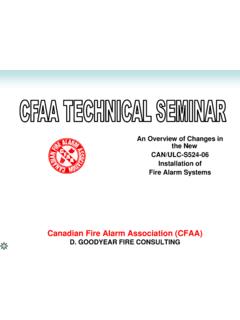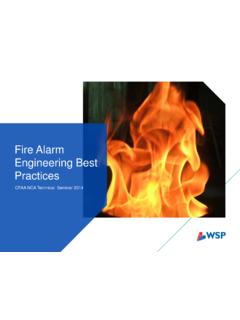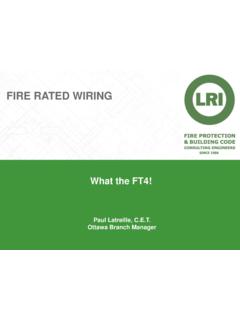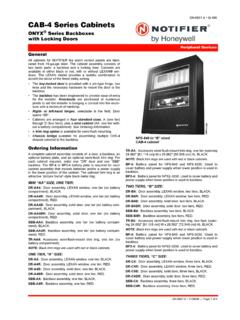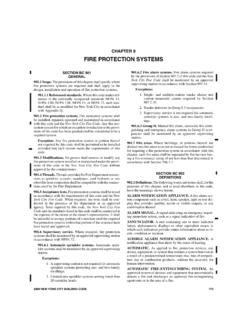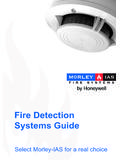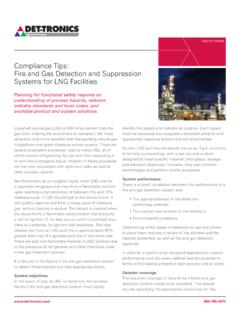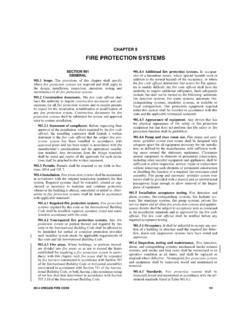Transcription of CBD-233. Fire Alarm and Detection Systems
1 CBD-233. fire Alarm and Detection Systems - NRC-IRC Page 1 of 5. CBD-233. fire Alarm and Detection Systems Originally published August 1984. McEwen fire Alarm Systems are normally required by building codes. In the case of new buildings, this is usually accomplished through the adoption of building regulations. In existing buildings, fire Alarm Systems may be required by municipal or provincial fire code provisions or by special provincial acts or municipal bylaws directed at specific classes of buildings. fire Alarm Systems are often associated only with pull boxes and Alarm bells. However, they are usually much more complex. They may include numerous components such as fire detectors, annunciator panels, loudspeakers, telephones, control panels and pull boxes. In addition to the Alarm function, fire Alarm and Detection Systems can also actuate other fire safety measures in a building. This Digest outlines, for the non-expert, the basic operation of typical fire Alarm Systems and the components of these Systems .
2 Functions The primary function of a fire Alarm is to alert the occupants of a building to the presence of a fire . It may also perform other functions. For instance, the system can be designed to simultaneously alert the fire department by means of a direct or relayed signal where a rapid response by the fire department is essential. This is particularly important in certain industrial occupancies containing large quantities of highly combustible or explosive materials where a fire can develop rapidly, and in high buildings, hospitals and nursing homes where evacuation assistance may be required. In other cases, because of the nature of the building occupancy, the Alarm system may be designed to alert initially only the building staff before the general Alarm is activated. fire Alarm Systems can be designed to control the operation of the building service equipment to minimize the spread of fire and smoke.
3 Signals from the system can automatically engage equipment to pressurize stairwells or shut down recirculating air Systems . This helps confine smoke to the fire floor and minimizes danger to life and property damage. The Alarm system can also be designed to activate smoke exhaust Systems to ventilate a fire and reduce heat build-up. Controls connected to the fire Alarm system can recall elevators automatically to the ground floor and remove them from public use. fire Alarm Systems may also be designed to activate fire suppression Systems , release hold-open devices on fire doors and indicate the location of the fire within the building. Components A typical fire Alarm system consists of a control unit, manually activated signalling boxes (pull boxes), fire detectors and audible Alarm devices. There may also be visual signal devices to warn the hearing-impaired, annunciators to indicate the origin of the Alarm signal, and emergency telephones and other equipment for communication 8/9/2008.
4 CBD-233. fire Alarm and Detection Systems - NRC-IRC Page 2 of 5. between the central control panel and other parts of the building (Figure 1). Figure 1. A basic fire Alarm system The control unit powers the fire Alarm system . It transmits signals from pull boxes (Figure 2) and fire detectors to the Alarm signal devices, either audible or visual, installed at strategic locations in the building. Audible signal devices include bells, speakers, and sirens, a strobe light being a common visual signal device. Figure 2. Pull station and emergency telephone The two basic types of fire detectors are smoke detectors and heat detectors. A smoke detector transmits a signal to the control unit when the concentration of airborne combustion products reaches a predetermined level. A heat detector transmits a similar signal when the temperature reaches a predetermined level or when there is an abnormal rate of temperature rise.
5 There are two principal types of smoke detectors: photoelectric and ionization. Photoelectric detectors react to visible particles of smoke. Ionization smoke detectors, on the other hand. are sensitive to the presence of ions, which are electrically charged particles produced by the chemical reactions that take place during combustion. Both ionization and photoelectric detectors are effective. Which one is better in a given situation depends on the nature of the fire . Hot gases with few smoke particles are more readily detected by ionization smoke detectors, while photoelectric detectors are 8/9/2008. CBD-233. fire Alarm and Detection Systems - NRC-IRC Page 3 of 5. more sensitive to cooler smoke with large smoke particles. These smoke detectors should not be confused with the self-contained devices commonly used in apartment suites and houses that are technically referred to as smoke alarms. Smoke alarms have a built-in audible Alarm device in addition to a smoke sensor, and are intended to warn only the occupants in the room or suite in which they are located.
6 Smoke detectors on the other hand are connected to the building fire Alarm system and are designed to initiate an Alarm signal to warn the occupants of the entire building. Heat detectors, like smoke detectors, when activated send a signal to the control unit to initiate an Alarm throughout the building. This type of detector is not prone to false alarms although it is rather insensitive to smoldering fires of low temperature. Automatic sprinklers can perform the same function as a heat detector. A water flow Alarm within the sprinkler system can be connected to the fire Alarm system , so that when the sprinklers operate, the fire Alarm system is activated. This form of fire Detection has the advantage of automatically suppressing the fire . In larger buildings, it is essential to be able to locate the zone of origin of an Alarm signal so that the source of the fire can be investigated quickly. The system is then designed so that a separate signal is transmitted by the fire detectors or pull boxes in each zone.
7 The division of the building into zones for fire Detection purposes will depend on the size and complexity of the building. One method of identifying the zone of origin of an Alarm signal is by the use of an annunciator panel. This annunciator panel identifies the zone of origin of the Alarm signal by means of an indicator light for each zone (Figure 3). In buildings with automatic sprinklers, the waterflow alarms are connected to the fire Alarm system to indicate the zone in which a sprinkler has been activated. Figure 3. A typical annunciator panel with indicators for each zone of the building The fire zone can also be determined if the Alarm system incorporates a "coded". 8/9/2008. CBD-233. fire Alarm and Detection Systems - NRC-IRC Page 4 of 5. audible signal in which a different signal is used for each zone. The advantage of this method is that staff can immediately identify the fire zone and go directly there to investigate.
8 Ho time is wasted going to the annunciator panel. In large buildings with many zones, a coded audible signal system may be unworkable. In other buildings, however, both an annunciator and coded Alarm signal can be used. Voice communication capabilities can be integrated into a fire Alarm system by connecting loudspeakers located throughout the building to a central control. In these cases, the audible Alarm signal operates for a predetermined period of time, after which it can be silenced while the loudspeakers are in use. These Systems enable fire department personnel to instruct the building occupants on procedures to follow during the fire . Emergency telephone sets (Figure 2) permit communication between the fire floor and the central control facility. In many installations, the speakers used to produce the audible Alarm signals also provide voice communications so that additional equipment is not required.
9 Types of Systems The basic types of fire Alarm Systems currently used in buildings are single and two- stage Systems . A single-stage system is designed so that when activated the Alarm signal is immediately transmitted throughout the building to warn the occupants that a fire emergency exists. In a two-stage Alarm system , a distinct alert signal first advises the staff of the fire emergency. Usually this signal is coded so that its meaning is apparent only to designated building staff. The staff are expected to immediately investigate the source of the Alarm and, if a fire exists, to activate the Alarm signal. The Alarm signal is automatically set off after a predetermined period of time (usually five minutes if the staff have not already activated it or reset the Alarm system . If, on the other hand, after investigation it is determined that the alert is a false Alarm , staff can silence the coded alert signal and reset the system .)
10 Silencing switches on an Alarm system are a potential hazard since the fire Alarm can be cancelled before a careful investigation has been carried out. It is essential that staff be instructed in the proper procedures to follow before silencing the Alarm . Two-stage Alarm Systems are normally used if programmed evacuation is required or if a general Alarm would cause undue distress to the occupants, for example in health care facilities. In these facilities the evacuation of the occupants is difficult and could be physically or psychologically harmful. Therefore two-stage Alarm Systems are used to reduce the possibility of false alarms. In some industrial occupancies containing significant quantities of combustible, flammable or explosive material, a fire can develop extremely rapidly, so it is important that there be no delay in evacuating the area. Accordingly, only single-stage Alarm Systems are permitted in these cases.
